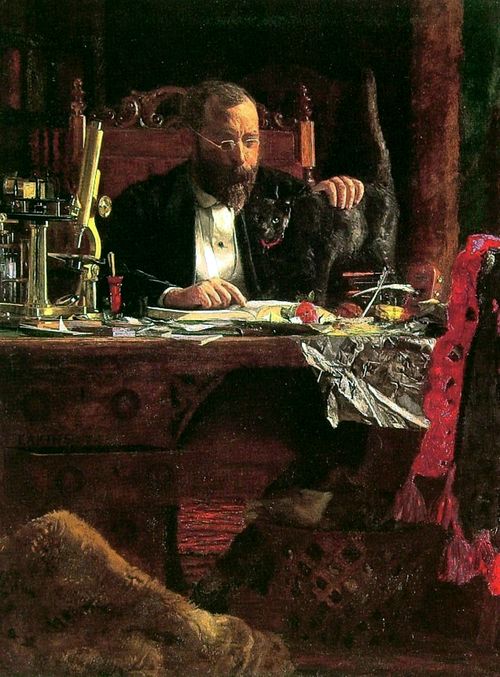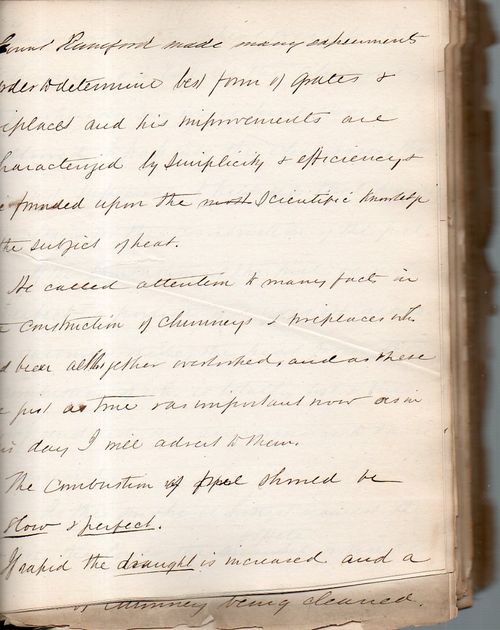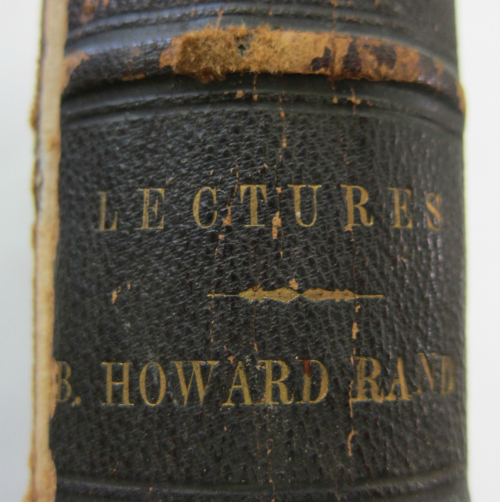JF Ptak Science Books
Manuscripts for general and applied sciences and engineering lectures delivered by B. Howard Rand (1827-1883) at the Franklin Institute, 1851-1853. During this time Rand [B(enjamin) Howard Rand, 1 Oct 1827 (Philadelphia) -14 Feb 1883] was a professor of chemistry at the Franklin Institute (1850-1853).
Rand evidently achieved some stature as he was the first subject chosen by Thomas Eakins for what would be his famous series of portraits of Philadelphia physicians1.(In April 2007, the portrait of Rand was purchased by Alice L. Walton for an estimated US$20 million, to be housed at the Crystal Bridges Museum of American Art2. )
Read More: http://www.ajronline.org/doi/full/10.2214/AJR.09.4064
"Rand was a popular teacher because he emphasized the applied rather than the theoretic applications of chemistry in the practice of medicine. He also had a lasting influence on the medical students because of his lectures on the social and professional responsibilities that the students would assume when they became physicians."--Stefan Schatzkil, "Portrait of Benjamin Howard Rand", Journal of Roentgenology, July 2010, volume 195/2.
The spine label "B. Howard Rand"
 [The portrait of Rand by Thomas Eakins. Source: New York Times http://www.nytimes.com/2007/04/12/arts/design/12pain.html?_r=0]
[The portrait of Rand by Thomas Eakins. Source: New York Times http://www.nytimes.com/2007/04/12/arts/design/12pain.html?_r=0]
10x8.5 inches, approximately 245 pages, running approximately 45,000 words. Includes lectures on
- "Improved Heating and Ventilation" (48 pages),
- "Geology" (44 pages);
- "On the Action of Running Water", (15 pages);
- "Warming", 40 pages); "Ventilation" (48 pages);
- "Physical Manual", (50 pages).
All are bound together, written on different stock, written seemingly by varying hands from time to time, and brought together in a leather-backed paper covered board volume. The pages are roughly cut, and the handwriting fast and untidy. The leather binding with marbled boards are quite worn, with the covers detached, though the rest of the book is intact and pretty sturdy. The text problems are limited to the first written page, which is missing the bottom of the page, roughly torn. Overall, the binding is in obvious need of restoration. $2000.
Provenance: given by Dr. W.H. Greene to the Franklin Institute Library (Philadelphia), 1895, where it stayed until 1986 when the library was generally disbanded. Dr. W.H. Greene was the translator of Elements of Modern Chemistry, Philadelphia, 1880; referenced in Henry Carrington Bolton's A Select Bibliography of Chemistry, 1492-18923.
Rand's previous appointments:
- Graduate of Jefferson Medical College (Philadelphia,1848), beginning his studies in 1843 with Dr. Robert M. Huston
- Clinical Assistant to Dr. Thomas Mutter and Dr. Joseph Pancost, 1846-1848
- Prof Chemistry, Franklin Institute, 1850-1855
And subsequently:
- Prof Chemistry, Philadelphia Medical College, 1853-4
- Philadelphia Academy of Natural Science, Secretary, 1853-1864
- Prof chemistry, Jefferson Medical College, 1864-1877
- Fellow of the Philadelphia College of Physicians 1853; fellow of the American Philosophical Society 1868; and, besides membership in other societies, was connected with the American medical association
- Author: An Outline of Medical Chemistry (1855); Elements of Medical Chemistry (1863)
It is an interesting collection of thinking on different subjects, and a peep into the life of the Franklin Institute and scientific dialog in Philadelphia in the mid-19th century.
Notes:
1. "The career of Thomas C. Eakins (1844–1916) has been explored in earlier articles in this series. There are several possible explanations why Eakins chose Rand for the first of the many portraits of Philadelphia physicians that he would complete during the following 30 years. The two probably became first acquainted while Eakins was a student at Philadelphia's Central High School, where Rand, also an alumnus of Central High, taught from 1859 to 1864, together with other responsibilities noted previously. Rand and Eakins shared a mutual interest and participation in the sport of rowing, the subject of some of Eakins' early and most renowned paintings. Rand was, for a time, president of the Philadelphia Undine Barge Club, where Eakins may have been a member. However, most interestingly, both men's fathers were well-known writing masters in Philadelphia."--Stefan Schatzkil, "Portrait of Benjamin Howard Rand", Journal of Roentgenology, July 2010, volume 195/2.
2. "Eakins' portrait of Rand is significant as the first in his series of portraits of physicians and scientists. Eakins portrayed the popular Dr. Benjamin H. Rand—a Jefferson Medical College professor with whom Eakins studied anatomy—lost in concentration at his desk, which is shown cluttered both with objects of science and academia and those of domestic life. Surrounded by the accoutrements of every aspect of life, Rand is poised between the world of intellectual endeavor and the comforts of home. The portrait was a great success for Eakins, earning a place at the Philadelphia Centennial's (1876) international art exhibition, where it won critical acclaim as one of the best paintings in the exhibition."--Art Daily





Comments